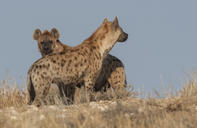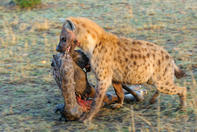
Spotted Hyena Appearance
Sloped Looking
The spotted hyena is a large carnivore with massive forequarters modified for carrying heavy carcasses. The large head and neck are well equipped with muscles to actuate the kinds of crushing and tearing jaw actions that hyenas use.
The enlarged forequarters give the hyena a sloped appearance and the front feet are larger than the hind to accommodate the extra forward weight. This body structure is also an adaptation to the loping energy-efficient gait used by hyenas when they forage.
Hyenas have exceptional senses with sight, especially night vision, smell and hearing all being excellent. A hyena’s olfactory capabilities are remarkable and animals may follow scent trails that are already three days old.
Spotty Coat
The spotted hyena gets its common name from the irregular dark spots on its pelage. Females gradually lose these markings with age. Young hyena are usually darker in colour than older ones.
Hyenas have a crest of hair that runs down their neck and shoulders. This is erectile and pilo-erection is used to make the individual appear larger to intimidate rivals or predators.
Strong Jaws
A hyena’s skull is as massive as a lion’s with a female’s skull weighing in at 3 kg. The large skull provides ample attachment for the muscles that action the powerful jaws which subsequently actuate the hyena's powerful bite. The hyena’s teeth equip it well for its lifestyle. The canines, assisted by the upper outer incisors, are heavy and provide lethal grip. The molars are adapted to crushing the densest bones and the carnassial shear, the flattened blade-like molar-premolar tooth arrangement common to all carnivores, enables hyena to slice through cartilage and tough skin.
By Megan Emmett


